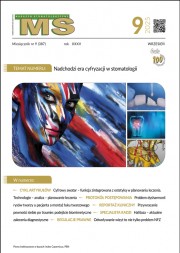Dostęp do tego artykułu jest płatny.
Zapraszamy do zakupu!
Po dokonaniu zakupu artykuł w postaci pliku PDF prześlemy bezpośrednio pod twój adres e-mail.
PIŚMIENNICTWO
1. Albander J.M., Kingman A.: Gingival recession, gingival bleeding and dental calculus in adults 30 years of age and older in the United States, 1988-1994. J. Periodontol., 1999, 70, 1, 3043.
2. Smith R.G.: Gingival recession. Reappraisal of an enigmatic condition and a new index for monitoring. J. Clin. Periodontol., 1997, 24, 201-205.
3.Tugnait A., Clerehugh V.: Gingival recession – its significance and management. J. Dent., 2001, 29, 6, 381-394.
4. Chrysanthakopoulos N.: Aetiology and severity of gingival recession in an adult population sample in Greece. Dent. Res. J., 2011, 8, 2, 64-70.
5. Pietruska M., Pietruski J.: Periodontologiczno- implantologiczna chirurgia plastyczna. Wyd. II. Wyd. Czelej, Lublin 2014, 54-56, 63-77, 86-89.
6. Dominiak M., Konopka T., Szajowski K.: Recesje dziąseł w odniesieniu do potencjalnych czynników etiopatologicznych. Stomatol. Współcz., 2002, 9, 22-28.
7. Khocht A., Simon G., Person P., Denepitiya J.L.: Gingival recession in relation to history of hard toothbrush use. J. Periodontol., 1993, 64, 900-905.
8. Zucchelli G., Mounssif I.: Periodontal plastic surgery. Periodontol. 2000, 2015, 68, 1, 333-368.
9. Escudero-Castaño N. i wsp.: Oral and perioral piercing complications. Open Dent. J., 2008, 2, 133-136.
10. Sarfati A., Bourgeois D., Katsahian S. i wsp.: Risk assessment for buccal gingival recession defects in an adult population. J. Periodontol., 2010, 81, 1419-1425.
11. Müller H.P., Stadermann S., Heinecke A.: Gingival recession in smokers and non-smokers with minimal periodontal disease. J. Clin. Periodontol., 2002, 29, 2,129-136.
12. Van Palenstein Helderman W.H., Lembariti B.S., Van der Weijden G.A., Van’t Hof M.A.: Gingival recession and its association with calculus in subject deprived of prophylactic dental care. J. Clin. Periodontol., 1998, 25, 106-111.
13. Gottlow J. i wsp.: New attachment formation in the human periodontium by guided tissue regeneration- case reports. J. Clin.Periodontol., 1986, 13, 290-296.
14. Miller P.D. Jr.: A classification of marginal tissue recession. Int. J. Periodontics Restorative Dent., 1985, 5, 2, 8-13.
15. Cairo F., Nieri M., Cincinelli S. i wsp.: The interproximal clinical attachment level to classify gingival recessions and predict root coverage outcomes: an explorative and reliability study. J. Clin. Periodontol., 2011, 38, 661-666.
16. Śmielak B., Suchorzewski A.: Leczenie protetyczno-periodontologiczne pacjentki z dehiscencją dziąsła i ubytkiem kości w okolicy zęba 13. Protet. Stomatol., 2006, LVI, 1, 33-36.
17. Stoner J.E, Mazdyasana S.: Gingival recession in the lower incisior region of 15-year oldsubjects. J. Periodontol.,1980, 51,74-76.
18. Mierau H.D., Fiebig A.: Zur Epidemiologie der Gingivarezessionen und moeglicher klinisher begletierscheinungen; Untersuchungen an 2410 18-bis 22 jahrigen. Dtsch Zaharztl.Z., 1986, 41,640-644.














